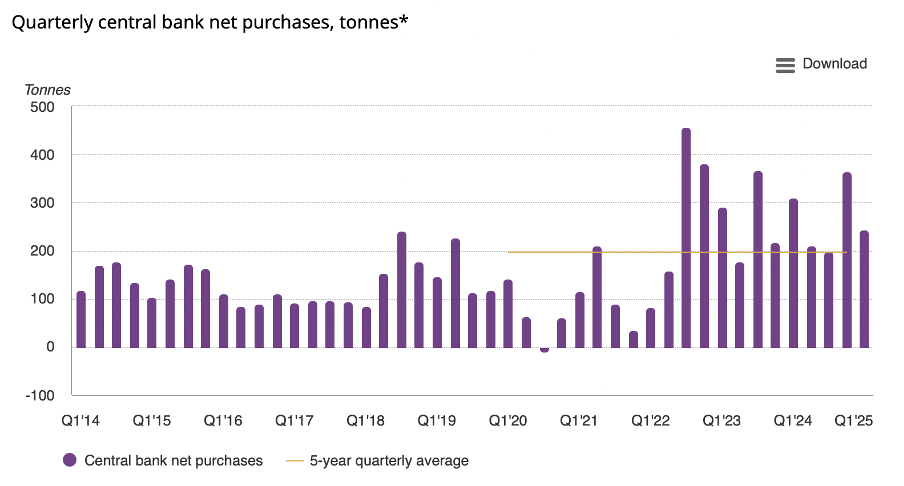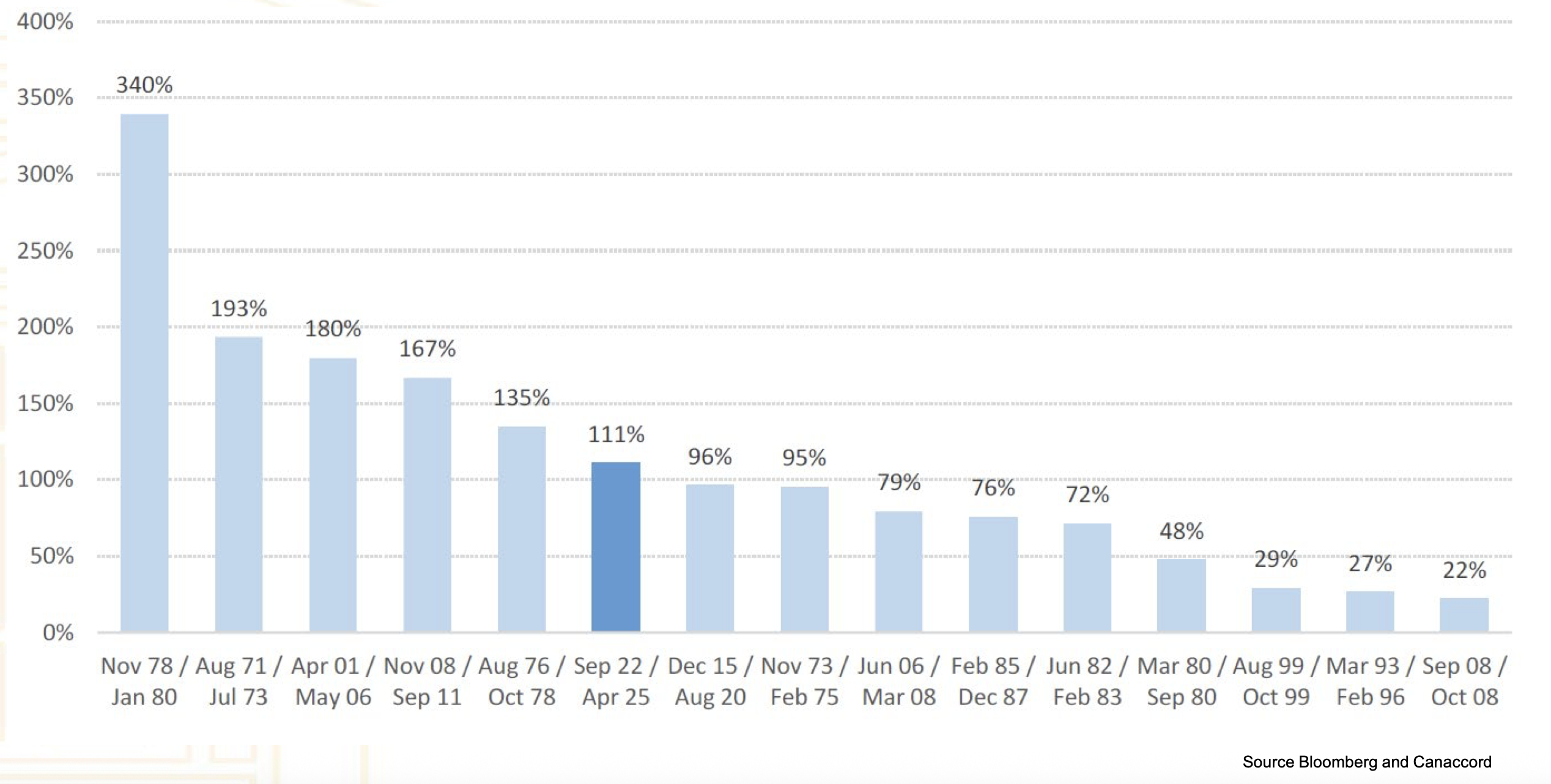Squandermania! Gold’s big bull run to 2030
Everybody knows one thing in financial markets.
US President Trump has a money problem. The American deficit needs handling. Constantly.
Markets are getting nervous how the US can keep financing its huge debt load.
I’m sure every international creditor is wondering along these lines. Foreigners hold trillions in US Treasuries.
It’s helping to drive up the gold price.
You can see that via the rise in central bank purchases of gold here…

2022 was the lift off point for this trend.
I don’t see much to slow it down overall. The quarterly numbers will swing around, of course, but the trend is up.
Australian fund manager Roscoe Widdup makes the following point…
“From a liquidity perspective gold bullion is … to our reckoning the only asset class that is actually sufficiently liquid and sufficiently defensive to be able to fill that gap of US treasuries…”
“And if you then translate that into central bank demand for gold in the traded gold market, that’s equivalent to adding a fifth of annual demand every year. An extraordinary amount.”
In other words, the starting gun on the gold bull market has gone. But there’s scope for the run to keep going.
That makes the entire gold sector rich in opportunity.
Almost every other commodity you care to name is down in the dumps: nickel, lithium, graphite, coal, oil.
Investors are only willing to back gold projects right now.
The AFR cites evidence that exploration spending is slumping to a four year low.
There’s one exception: gold projects!
See this bit:
“The precious metal attracted $621.2 million in financing during the quarter – more than double the figure from the same period last year. This surge is attributed to gold’s traditional role as a safe-haven asset amid ongoing global economic volatility.”
If you want to invest into mining, there’s only one commodity to back right now, unless you have nerves of steel and endless patience.
You guessed it: gold!
I think we’re on track to repeat the extraordinary lithium boom that ran, with a big dip or two on the way, from 2015-2023.
Gold shares bottomed out in 2022. But the juniors are only really lifting now. Trump’s second Presidency lasts until 2029.
This is highly likely to send the gold industry all over the world looking for the stuff. The high gold price will keep them at it. We can “thank” Trump for that.
Here’s another angle on this idea…
Here’s a look at the percentage moves in gold bull markets over the last fifty years or so.
You can see the current bull run highlighted too in the darker shade of blue…

Hopefully, you find this encouraging. We’re a long way from the biggest move yet.
It’s certainly possible this record is eclipsed by 2030. I can’t guarantee it, but I firmly believe it could happen.
Why so?
Look around you. Governments all over the world are saturated in debt. Demographics are terrible.
It’s almost impossible for Western governments to meet their ballooning liabilities as the baby boomer generation retires and lives longer than their parents.
That reminds me…
Back in 2019, two economists named Charles Goodhart and Manoj Pradhan wrote a prescient book called The Great Demographic Reversal.
They show us how — for 35 years — the West coasted off two demographic tailwinds.
One was the gigantic supply of cheap Chinese labour that entered the global workforce.
The second factor was big economies like the US and Germany enjoying the ‘demographic dividend’ of a healthy number of workers relative to retirees and other dependents.
Those days are history.
The worsening worker-dependency ratio across the West is going to send aged care and pension costs on an intractable march higher…with less economic growth likely to pay for them.
Result?
We can expect chronic and growing government deficits for years to come.
These will either need higher taxes to fund them or, more likely, more central bank financing to pay for them.
All this is putting a huge drag on global capital markets
It would be less so if this debt was financing global infrastructure or investing in new technologies.
But so much US and international government spending is for health, social security, the military…and just interest on the debt already owed.
These are transfer payments, mostly. I call it Squandermania.
I first used that term in 2022 for an issue of Australian Small Cap Investigator – about a month before gold stocks bottomed out in Australia.
Where does that leave us?
We know government debt is unsustainable. We know today’s “fiat” money can be created at will.
Horse, meet water.
Gold was long considered a “chaos” hedge…
…and protection against market sell offs and financial crisis.
It can be that, for sure.
But for now, the markets are bidding on both, because it’s inherently protection against currency depreciation.
This is why bitcoin is surging toward new highs as well.
Governments run on fiat money, and fiat money can be created endlessly.
Real assets cannot, because factors rooted in the real world are a constraint.
The whole picture?
The inflation demon is embedded in the system now. In fact, a big surge could start within the next 18 months, according to banking expert Dr. Richard Werner.
He expects the US gold price to go to US$10,000 per ounce by the end of this bull run.
This isn’t really that crazy when you consider the “refinancing wall” that looms over the global economy.
All these debts all over the place constantly issued need to be settled or rolled over at some point.
And that point keeps getting shorter.
The total US federal debt is around US$37 trillion.
One estimate puts 75% of this figure - US$28 trillion – needs to be refinanced between 2025 and 2029.
One gimmicky move the US can pull is to issue a lot of short term debt to the market. The trap: they have to keep rolling it over.
This debt will be refinanced at a higher rate, if rates stay elevated.
That’s just the USA.
Over in Japan they have a debt-to-GDP ratio of over 300%. Rates are rising there too.
On my desk at the office is a book called “When Money Dies”.
It’s about the Weimar hyperinflation in Central Europe after the First World War.
Who survived the chaos?
It sure wasn’t the bondholders, or retired civil servants on a government pension, that’s for sure. They got wiped out.
Of course, we’re not at the dramatic stage of collapse, either. But any large bond holder is likely feeling mighty nervous about what’s coming down the line.
They probably can’t all exit for the door, certainly at once. But they can hedge their risk via gold and bitcoin especially.
Higher prices for both look very likely over the medium term.
This makes holding gold or gold stocks a must!
This is why you might have heard recently about Jamie Dimon.
He’s head of the biggest American bank, JP Morgan.
Dimon recently stated:
“You are going to see a crack in the bond market.”
And…
“You are going to panic.”
Now, a word of caution. Just because he says it doesn’t mean it’s going to happen tomorrow.
But he can see what we see.
Implied in Dimon’s warning is that you and I better have a plan in place for when this scenario goes down.
That means a permanent allocation to gold in some way, at least to me.
Go back to the chart above. The two biggest gold moves came within 10 years. They were
· August 1971-July 1973
· November 1978-January 1980
Both had a similar background. A rise in inflation from excessive government spending, financed with freshly printed dollars.
Fast forward to now.
We know that central banks created a staggering amount of new money after the Covid collapse. That led to the inflationary surge in 2022.
That slaughtered bonds and stocks for a while. But it also set the stage for gold’s recent big run. The only surprise was how long it took gold to move.
Now, inflation is cooling off again…for now!
However…
That brings us back to Jamie Dimon and the “Great Demographic Reversal”.
At some point central banks will be forced to inflate again. That will put major bond markets in a whole lot of trouble.
It will likely send gold prices higher as investors move to protect themselves.
Do you get what I’m telling you?
You and I are on an asset market roller coaster
Central banks like to pontificate about ensuring “financial stability”.
That’s good public relations, but it’s simply not possible in the world we live in.
It’s all based on unsustainable government spending, rickety demographics and financial tricks to make it look like it “works”.
Your wealth, your retirement, the future of your family – mine too - are all linked to this ticking bomb. There’s no escaping the implications.
Then there’s the whole international order disintegrating around the whole shebang too.
It would only take one rogue Russian – or Iranian, or Chinese - missile into neutral territory to send America’s 21st century “Pax Romana” up in flames.
This is likely going to ensure gold’s appeal for a long time.
Inflation and geopolitical uncertainty are as certain for the next five years as anything in financial affairs can be.
Portfolio managers will allocate to the gold sector with this in mind. It helps that gold miners are minting money too.
One way to potentially benefit from this is to get set into gold stocks
The best part about investing in the gold sector is you can move up and down the risk curve, from explorers to developers to producers.
You can even get access to royalty firms in North America. Then there’s gold coins, bullion bars and the other precious metals.
You can decide where you want to go here. Of course, investing in shares is risky, especially commodity stocks, so always discuss any possible action with your personal financial advisor.
When it comes to gold shares…
Bull markets like this can run for years.
Here’s a bit of advice on this opportunity, worth what you pay for it.
Don’t get caught up in the monthly and quarterly swings here.
Decide now if you want to have a crack at the bull run in precious metals and commit.
The truly huge gains in the share market can only come from hanging on, come what may.
That includes big draw downs, and periods of “underperformance”.
Case in point is the lithium boom from 2015 to 2023.
With luck, you might have bought Liontown Resources ($LTR) at 2 cents in about 2016.
It’s not crazy to think you might have found your way there.
Elon Musk and Tesla were just going from the fringe toward the mainstream at the time. And lithium stocks were rallying around then too.
I can say all this confidently. I’ve been doing this gig for so long I wrote a report about it.
(The report was called “Electric Gold”. Ha!).
Imagine riding LTR all the way up, for a moment, and savour the idea.
LTR nearly got to $3 per share at the peak in 2023 – a rise of just under 15,000%.
It helped make its major shareholder, Tim Goyder, a billionaire, at least for a while.
It took eight years, and some wild swings in markets over the same time frame – including the Covid collapse.
There’s nothing easy about hanging on for the long haul.
But LTR went from obscure explorer to a producing miner.
(Unfortunately for LTR, the lithium winter is killing its mojo currently.)
So…
We know there’s big money in exploration firms when it all comes together
Right now, the tailwind is not with lithium firms, but gold stocks.
The team at L1 Capital wrote recently…
“Our gold positions performed strongly despite the gold price being flat, driven by strong Q1 results, positive major project updates and growing investor confidence in sustainably higher gold prices amid macro/geopolitical volatility.”
That last bit is the important one to me. Investor confidence!
Why do we care?
It’s this confidence that will cause investors to part with their money, and back medium to small gold juniors, especially the explorers.
The biggest shot at wealth creation is in the discovery phase for an explorer.
You can look at a map of Australia as a treasure map of gold finds.
Now the race is on to unlock more gold deposits.
In mining circles, there’s a concept called the Lassonde Curve. This is a theoretical pathway from exploration to production.
The best places to make money, in theory, are at either end of the curve.
That’s either in the exploration phase, or going into production, usually after years of groundwork (metaphorically and literally).
For this to happen, you need to own a firm that hits a new, exciting gold deposit.
Spartan Resources ($SPR) is a recent example of this on the ASX.
It was almost bankrupt until it drilled into a new deposit called Never Never…finding gold at great grades, nearby to its existing infrastructure…which saved the company.
SPR 10x:
20 cents to over $2 per share, all within about 2 years. Nice!
That’s the potential in the gold sector. It’s these kinds of stories, too, that seed investor willingness to have the next crack.
For example….
I was at a small presentation recently for a gold developer. They have 2 options to get into production.
The specifics don’t matter. One way was conservative, and the other aggressive.
The managers leaned toward the softly, softly approach.
One analyst in the room effectively said, ‘Are you crazy? In this gold market, go BIG!’
In other words, stick your hand out and take investor capital while the going is good.
This dynamic is important if you decide to invest in junior miners.
You want to have reasonable confidence that they won’t get left stranded, without access to capital.
That can send a junior miner broke, in the worst case scenario.
That’s why, if you want to ride the start of the Lassonde Curve today – the riskiest, I might add – it needs to be in the gold sector.
It’s also why I’m so chuffed with my latest idea to exploit the junior gold sector on the ASX. It’s a way to do it without the heart stopping fear of bankruptcy.
It’s the “softly, softly” approach to exploiting the gold sector. You can hang on for the long haul, too, knowing you’re in good hands.
Curious?
Best wishes,
Callum Newman
Editor, Fat Tail Investment Research
1 topic

